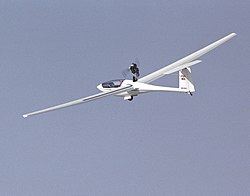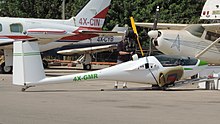Eiri Avion PIK-20
| Eiri Avion PIK-20 | |
|---|---|

|
|
| Type: | Glider |
| Design country: | |
| Manufacturer: | |
| First flight: |
October 10, 1973 |
| Production time: |
1974-1980 |
| Number of pieces: |
> 425 (all variants) |
The PIK-20 is a single-seat glider from the student association PIK , which was manufactured in series at Eiri Avion.
history
The PIK-20 was developed by students at Helsinki University of Technology . The main designers were the members of Markku Hiedanpää, Hannu Korhonen and Pekka Tammi. The PIK-20 used flaps instead of Schempp-Hirth flaps in order to keep the speed below v NE in accordance with the building regulations when diving with the landing aid fully extended . The aircraft was designed according to the rules of the time for the standard class , which allowed flaps if they were the only landing aid and could only be used for landing.
A prototype made in 1972/1973 had its maiden flight on October 10th in Jämijärvi . The flaps were operated with a crank and could be moved up to 90 °. The first flight pilot Raimo Nurminen achieved 13th place in the standard class with the plane at the 1974 World Cup in Waikerie (Australia).
A little later, the rules of the standard class were changed again, which now only required that the flaps should not be moved together with the ailerons or overlaid with them. The lift-increasing or performance-improving properties of the flaps were not restricted. With the PIK-20B adapted to this rule change, the British, American and Finnish national championships were won in 1975 and the world championship in 1976 by Ingo Renner and places 2 and 3.
As an option, the PIK-20B was offered as one of the first gliders with carbon fiber spars, which reduced the weight of the wings by around 30 kg. The hood frame is pneumatically sealed.
Following the success of the planes equipped with flaps, the IGC banned all profile-changing lift aids in the standard class and created the new 15 m class (racing class) . The PIK-20D was designed for this class. It had 1: 1 superimposed flaps and Schempp-Hirth flaps that only extended on the top for landing. The wing spar was now made from carbon fibers as standard , and carbon fibers were also used for reinforcement in some other places (fuselage tube to absorb the bending forces of the rudder , cockpit frame).
Performance measurements showed that the PIK-20D had poorer gliding performance than the PIK-20B. Therefore some design changes have been made. The nose of the fuselage was made more pointed and the horizontal stabilizer moved a few centimeters forward. The reason for the deterioration in performance was an increased profile thickness, probably caused by warped shapes for the wings.
Jukka Tervamaki integrated a motor into a PIK-20B and thus developed the prototype JT6 for the later PIK-20E with a 43 (50) hp Rotax 501 / ( Rotax 503 ). For the PIK-20E, reinforced wing spars, a larger central section of the fuselage and, due to the shifting of the center of gravity to the rear, a rear sweep of the wings by 2 ° were required.
A special feature of the PIK-20 was its manufacturing process: All components were made from epoxy resins , which have increased temperature resistance. The parts were then tempered in an autoclave . The usual gelcoat was also completely dispensed with as a layer of lacquer, instead the parts were then lacquered with acrylic lacquer. Due to the increased temperatures during tempering, the PIK-20 can also be painted in colors other than white, namely chrome yellow ( RAL 1007), blood orange (RAL 2002), gentian blue (RAL 5010), yellow green (RAL 6018) or white aluminum (RAL 9006).
On May 7, 1996, the PIK-20D subsequently received aerobatic approval (“Aerobatic Category”) in the range of +6.6 g to −4.6 g in a “Design Change” . Allowed aerobatic maneuvers are spin , turn , rolls , looping , inverted , inverted flight curves, barrel rolls , and combinations thereof (eg. B. Immelmann , clover, Cuban Eight etc.). Prohibited aerobatic figures are uncontrolled figures ( cracked / pushed rolls), figures in which the aircraft flies backwards ( males , females), figures with long-lasting negative stress (external looping) and back spins.
The flight performance of a PIK-20A was measured at the Idaflieg summer meeting in Aalen-Elchingen in 1975 , the PIK-20D and PIK-20E followed in 1977 and 1979.
Technical specifications
| Parameter | PIK-20 | PIK-20B | PIK-20D | PIK-20E |
|---|---|---|---|---|
| crew | 1 | |||
| length | 6.43 m | 6.45 m | 6.53 m | |
| span | 15 m | |||
| height | 1.34 m | 1.45 m | 1.47 m | |
| Wing area | 10 m² | |||
| Wing extension | 22.5 | |||
| profile | Root: FX 67-K-170; Edge curve: FX 67-K-150 | |||
| Slightest sinking | 0.58 m / s (73 km / h) at 320 kg | 0.56 m / s (73 km / h) at 300 kg |
0.61 m / s (77 km / h) at 360 kg |
|
|
Glide ratio with maximum payload |
40.5 at 100 km / h | 41.5 at 115 km / h | 42 at 103 km / h | 41 at 117 km / h |
| Empty mass | 240 kg | 220 kg | 290 kg | |
| Water ballast | 80 kg | 140 kg | 120 kg | |
| Max. Takeoff mass | 400 kg | 450 kg | 470 kg | |
| Max. Wing loading | 40 kg / m² | 45 kg / m² | 47 kg / m² | |
| v NE (maximum speed) | 262 km / h | 292 km / h | 285 km / h | |
| v B | 242 km / h | 240 km / h | 215 km / h | |
| v A (maneuver speed) | 185 km / h | 190 km / h | ||
| v T (aircraft tow start) | 185 km / h | 190 km / h | ||
| v W (winch start) | 125 km / h | |||
| Minimum speed | 60 km / h | 66 km / h | ||
| Load factor | +5.3 g to −2.65 g | +6.6 g to −4.6 g | +5.3 g to −2.65 g | |
| Engine | - | Rotax 501, 31.6 kW (43 PS) or Rotax 503 , 37.3 kW (50 PS) |
||
Web links
- Test aircraft ( Memento from February 6, 2005 in the Internet Archive )
- PIK-20D
Individual evidence
- ↑ a b Dietmar Geistmann: The development of plastic gliders . 1st edition. Motorbuch Verlag, Stuttgart 1976, ISBN 3-87943-483-2 , p. 182-184 .
- ^ Ralf Schneider: 75 years of Idaflieg - 1922–1997 . M. Wehle Verlag, Witterschlick / Bonn 1997, ISBN 3-89573-045-9 , p. 203 .
- ↑ a b A. Coates: The gliders and motor gliders of the world . 1st edition. Motorbuch Verlag, Stuttgart 1981, ISBN 3-87943-763-7 , p. 84 f .
